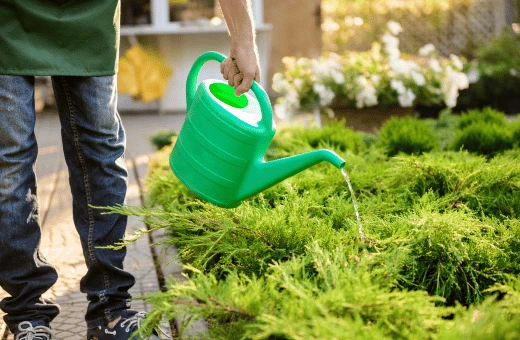In an era where the pressures on water resources are increasing, effectively managing water usage in landscaping has become essential. Various methods to reduce water consumption in landscaping serve as crucial tools for environmental protection and ensuring the sustainability of green spaces. Have you ever wondered how to achieve this? Managing water usage in landscaping requires the right strategies, such as selecting appropriate plants, implementing modern irrigation techniques, and adopting other effective practices. By understanding how to reduce water consumption, we can preserve the environment while enhancing the beauty of our gardens.
What are the most effective ways to manage water usage in landscaping
To effectively manage water usage in landscaping, there are several strategies you can adopt. These methods not only help conserve water but also ensure that plants thrive with minimal waste.
Efficient Watering Practices
One of the most basic yet essential approaches is to water plants only when necessary. Overwatering leads to water wastage, and knowing how much water your plants need is key. Understanding plant water requirements and the concept of evapotranspiration (ET)—the sum of water evaporation from the soil and transpiration by plants—can guide your watering schedule. Replacing the water lost to evapotranspiration ensures that plants stay healthy without overuse. Adjusting irrigation systems based on local ET rates, which can be obtained from water districts or agricultural extension services, is an effective way to conserve water.
Watering during the early morning is another crucial method. This reduces evaporation caused by the midday sun and wind, allowing plants to absorb water efficiently before temperatures rise.
Xeriscaping
A highly water-efficient landscaping technique is xeriscaping, which focuses on minimizing water usage through proper planning and plant selection.
Planning and Design:
Start by mapping out a landscape that considers the local climate. Choose areas that will require minimal watering and group plants according to their water needs.
Selecting Plants:
*Opt for native plants or those that naturally thrive in your local climate, as they typically need less water. Grouping plants with similar water needs, also known as “zoning,” helps reduce unnecessary watering.
Soil Improvement:
Adding organic matter or soil conditioners improves the soil’s water retention capacity, encouraging deeper root growth and reducing the need for frequent watering.
Turf Reduction:
Traditional bluegrass lawns require a lot of water, so reducing turf areas or switching to low-water-use grasses significantly cuts down water usage.
Efficient Irrigation Systems
Using efficient irrigation systems is critical. Drip irrigation is a popular choice for watering ornamental plants and shrubs because it delivers water directly to the roots with minimal waste. Ensure that sprinkler systems are adjusted to prevent water runoff or spraying onto non-planted areas like sidewalks or driveways. Regular maintenance, such as checking for leaks or clogged lines, keeps the system running smoothly.
Mulching
Applying mulch around plants and shrubs helps retain soil moisture by reducing evaporation, keeping the roots cool, and preventing weed growth. Mulch also enhances soil structure, further promoting water retention.
Additional Conservation Methods
- Use a rain shut-off device or moisture sensor to prevent overwatering during rainy conditions or when the soil is already moist.
- Raising lawn mower blades helps shade the soil, reducing evaporation and the need for frequent watering.
- Simple actions like using a broom instead of a hose to clean hard surfaces or using hoses with automatic shut-off nozzles can save significant amounts of water.
What are 5 ways to reduce water usage?
Here are five effective strategies to lower water consumption in landscaping:
- Opt for Native Landscaping: Choosing native plants for your garden is a great way to minimize water use. These plants are naturally suited to your local environment, requiring less water, fertilizers, and maintenance compared to non-native species. For example, if you live in a dry region, planting succulents or drought-resistant flowers can significantly reduce your water needs.
- Use Mulch: Applying a layer of mulch around your plants not only enhances the aesthetic appeal of your garden but also plays a crucial role in retaining soil moisture. This practice helps to reduce the frequency of watering, as mulch acts as a barrier against evaporation. Organic mulches, such as wood chips or straw, can also enrich the soil as they decompose.
- Water Plants Wisely: Timing is key when it comes to watering your garden. Watering early in the morning or late in the evening minimizes evaporation and ensures that your plants receive the moisture they need without unnecessary waste. This approach can lead to healthier plants while conserving water.
- Use Drip Irrigation or Soaker Hoses: Implementing drip irrigation systems or soaker hoses can dramatically improve water efficiency. These systems deliver water directly to the roots of the plants, reducing runoff and evaporation. By focusing water delivery where it is most needed, you can ensure that your plants thrive while using less water.
- Collect Rainwater: Installing rain barrels to capture rainwater is an innovative and sustainable way to conserve water for garden use. This method not only reduces your dependence on municipal water sources but also helps manage stormwater runoff. You can use the collected rainwater for watering plants, making it an eco-friendly solution.
The question of whether indigenous (native) or non-indigenous (non-native) plants require more water doesn’t have a straightforward answer, as it largely depends on various factors, including the specific species in question and their growing conditions. Here’s a more detailed exploration:
Water Requirements of Native vs Non-Native Plants
- Variety of Water Needs: The water requirements of both native and non-native plants can vary widely based on the specific species. Some native plants are adapted to arid environments and have evolved to require less water, while certain non-native plants, especially those from wetter climates, may demand more.
- Growing Conditions: Typically, plants in open ground, which is where many native plants thrive, tend to require less water than potted plants. This is because plants in the ground can develop deeper root systems, allowing them to access moisture from lower soil layers. In contrast, potted plants (often non-native) may not have the same access to moisture, making them more dependent on frequent watering.
- Environmental Factors: Several environmental factors also influence a plant’s water needs, such as sunlight, temperature, and humidity. For instance, a non-native plant in a hot, dry climate may require more water to thrive than a native plant well-adapted to those conditions.
- Adaptations: Native plants often have adaptations that help them conserve water. These adaptations can include smaller leaves, deep root systems, and waxy coatings on leaves that reduce water loss. Non-native plants may not possess these adaptations and could require more frequent watering in similar environments.

